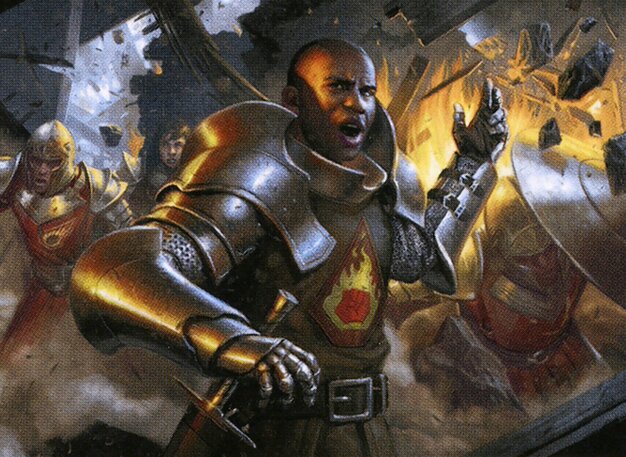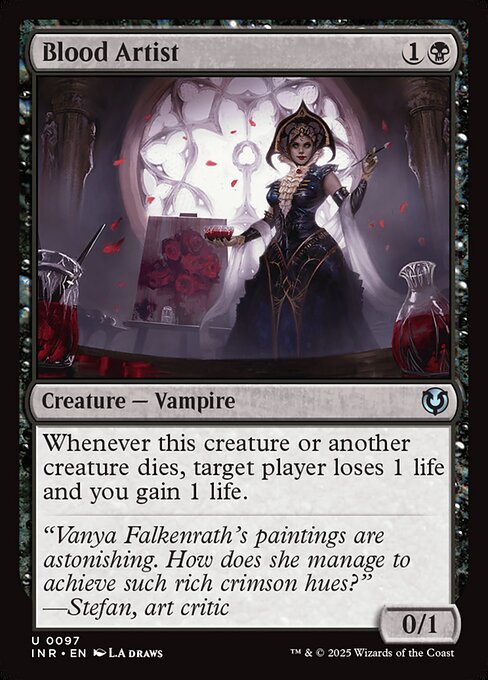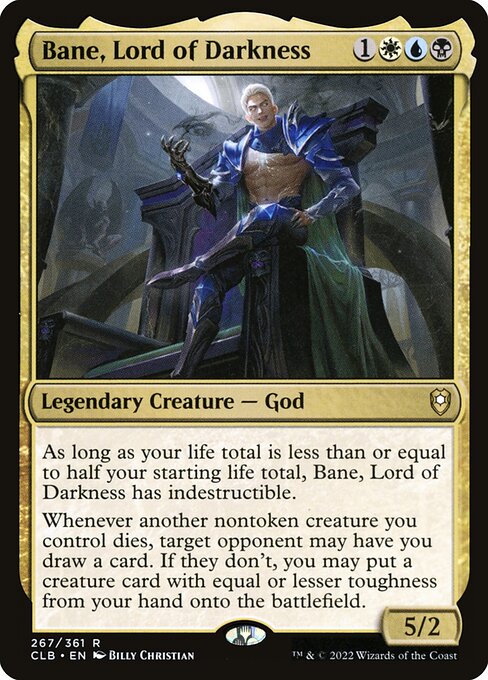Deck & Commander Strategies

Urabrask, Heretic Praetor
Aggressive mono-red midrange deck that generates treasure tokens to ramp and supports fast, resilient creatures to pressure opponents quickly.

Bane, Lord of Darkness
Esper reanimator and sacrifice deck that uses discard and recursion to maintain card advantage and board control, aiming to leverage creatures with death triggers.

Myrkul, Lord of Bones
Abzan enchantress and reanimation deck that converts creatures to enchantments, protecting key pieces from removal and enabling synergies with sacrifice outlets and drain effects.

Duke Ulder Ravengard
Boros midrange with myriad creatures that focuses on generating multiple attackers and gaining incremental card advantage through creatures dying.
Gameplay Insights
- 1
Myrkul's ability to convert creatures into enchantments effectively protected key creatures from creature removal, enabling the player to maintain board pressure despite opponent interference.
- 2
The synergy between Bane's reanimation and sacrifice mechanics allowed consistent card draw and disruption, creating a resilient game plan against removal-heavy decks.
- 3
Duke Ulder Ravengard's myriad ability took advantage of combat phases to generate multiple attackers, which required opponents to carefully manage blockers and removal timing.
- 4
Urabrask's treasure token generation provided flexible mana acceleration, enabling faster deployment of threats and reactive spells to maintain tempo.
- 5
Faithless Looting and discard spells were pivotal in setting up graveyard interactions and filtering draws to find key combo pieces or answers.
- 6
The interaction of enchantment conversion with sacrifice outlets created a layered defense and offense that shaped the mid-to-late game board state.
Notable Cards
-

Patron of the Arts
-

Blood Artist
-

Cultivate
-

Faithless Looting
-

Talisman of Hierarchy
-

Reassembling Skeleton
Gameplay Summary
The game began with each player carefully developing their mana bases and setting up for their mid-to-late game strategies.
Early turns were slow, with players playing ramp spells like Cultivate and setting up key lands.
Urabrask, Heretic Praetor's player focused on aggressive board presence supported by treasure generation, while Myrkul, Lord of Bones aimed to convert creatures to enchantments and leverage reanimation synergies.
Bane, Lord of Darkness sought to capitalize on sacrifice and reanimation mechanics to draw cards and maintain board control.
Duke Ulder Ravengard's player aimed to deploy a midrange strategy with myriad creatures, focusing on board presence and incremental card advantage. As the game progressed, interactions between removal, sacrifice outlets, and recursion became pivotal.
The player commanding Myrkul utilized enchantment conversion to protect key creatures from removal, enabling combos with Blood Artist-like effects to drain opponents.
Meanwhile, the Bane player leveraged discard and reanimation to maintain pressure and disrupt opponents' hands.
Duke Ulder's myriad tokens provided multiple attackers, though without haste, requiring careful timing.
Urabrask's treasure tokens and aggressive creatures helped maintain tempo.
The game saw a critical phase where Myrkul's enchantment synergy and Bane's reanimation became threats that the others had to answer, with key plays like Tenderhoot Dryad and Patron of the Arts enhancing board states.
Ultimately, the game revolved around the interplay of sacrifice, recursion, and incremental advantage until a decisive combo or overwhelming board state emerged.
![Duke Ulder vs Bane vs Myrkul vs Urabrask [Budget EDH/Commander, MTG Gameplay 2022] thumbnail](https://i.ytimg.com/vi/EjVlvTBkRBs/maxresdefault.jpg)





![Yarok vs Inalla vs Nekusar vs Yuriko [EDH Gameplay] 2019 thumbnail](https://i.ytimg.com/vi/DMN5TuN0Lhw/sddefault.jpg)
![Lord Windgrace vs Tuvasa vs Niv Mizzet vs Yuriko [EDH Gameplay] 2020 thumbnail](https://i.ytimg.com/vi/PVpLAAPdUg0/sddefault.jpg)
![Zacama vs Lord Windgrace vs Kalamax vs Nicol Bolas [EDH Gameplay] 2020 thumbnail](https://i.ytimg.com/vi/gxW36IDCHOg/sddefault.jpg)
![Tuvasa vs Drana vs Greven vs Yuriko [EDH Gameplay] 2020 thumbnail](https://i.ytimg.com/vi/-hHy2sHIzKw/sddefault.jpg)
![Ojutai vs Kalamax vs Greven vs Niv-Mizzet [EDH Gameplay] 2020 thumbnail](https://i.ytimg.com/vi/t177nY7wtgk/sddefault.jpg)
![Atla Palani vs Zacama vs Nekusar vs Nicol Bolas [EDH Gameplay] 2020 thumbnail](https://i.ytimg.com/vi/LPKjyt_EYrM/sddefault.jpg)
![Meren vs Tuvasa vs Greven vs Jhoira [EDH Gameplay] 2020 thumbnail](https://i.ytimg.com/vi/R-bM2TKK7gE/sddefault.jpg)
![Kadena vs Jhoira vs Ojutai vs Xyris [EDH Gameplay] 2020 thumbnail](https://i.ytimg.com/vi/UBhOd0Xh4oM/sddefault.jpg)
![Xyris vs Grimgrin vs Mogis vs Illuna [EDH Gameplay] 2020 thumbnail](https://i.ytimg.com/vi/pHo2vOPZ0vg/sddefault.jpg)
![Sharuum vs Grimgrin vs Mogis vs Kynaios and Tiro [EDH Gameplay] 2020 thumbnail](https://i.ytimg.com/vi/QpJrr_CcH2M/sddefault.jpg)






















